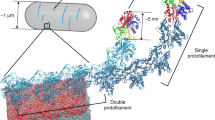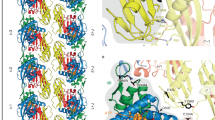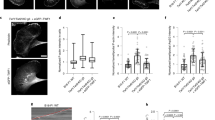Abstract
The bacterial actin homolog MreB, which is crucial for rod shape determination, forms filaments that rotate around the cell width on the inner surface of the cytoplasmic membrane. What determines filament association with the membranes or with other cell wall elongation proteins is not known. Using specific chemical and genetic perturbations while following MreB filament motion, we find that MreB membrane association is an actively regulated process that depends on the presence of lipid-linked peptidoglycan precursors. When precursors are depleted, MreB filaments disassemble into the cytoplasm, and peptidoglycan synthesis becomes disorganized. In cells that lack wall teichoic acids but continue to make peptidoglycan, dynamic MreB filaments are observed, although their presence is not sufficient to establish a rod shape. We propose that the cell regulates MreB filament association with the membrane, allowing rapid and reversible inactivation of cell wall enzyme complexes in response to the inhibition of cell wall synthesis.
This is a preview of subscription content, access via your institution
Access options
Subscribe to this journal
Receive 12 print issues and online access
$259.00 per year
only $21.58 per issue
Buy this article
- Purchase on Springer Link
- Instant access to full article PDF
Prices may be subject to local taxes which are calculated during checkout






Similar content being viewed by others
Accession codes
References
Garner, E.C. et al. Coupled, circumferential motions of the cell wall synthesis machinery and MreB filaments in B. subtilis. Science 333, 222–225 (2011).
Domínguez-Escobar, J. et al. Processive Movement of MreB-Associated Cell Wall Biosynthetic Complexes in Bacteria. Science 333, 225–228 (2011).
van Teeffelen, S. et al. The bacterial actin MreB rotates, and rotation depends on cell-wall assembly. Proc. Natl. Acad. Sci. USA 108, 15822–15827 (2011).
Kim, S.Y., Gitai, Z., Kinkhabwala, A., Shapiro, L. & Moerner, W.E. Single molecules of the bacterial actin MreB undergo directed treadmilling motion in Caulobacter crescentus. Proc. Natl. Acad. Sci. USA 103, 10929–10934 (2006).
Salje, J., van den Ent, F., de Boer, P. & Löwe, J. Direct membrane binding by bacterial actin MreB. Mol. Cell 43, 478–487 (2011).
Reimold, C., Defeu Soufo, H.J., Dempwolff, F. & Graumann, P.L. Motion of variable length MreB filaments at the bacterial cell membrane influences cell morphology. Mol. Biol. Cell 24, 2340–2349 (2013).
Ingerson-Mahar, M. & Gitai, Z. A growing family: the expanding universe of the bacterial cytoskeleton. FEMS Microbiol. Rev. 36, 256–266 (2012).
Chastanet, A. & Carballido-López, R. The actin-like MreB proteins in Bacillus subtilis: a new turn. Front. Biosci. (Schol. Ed.) 4, 1582–1606 (2012).
Kawai, Y., Asai, K. & Errington, J. Partial functional redundancy of MreB isoforms, MreB, Mbl and MreBH, in cell morphogenesis of Bacillus subtilis. Mol. Microbiol. 73, 719–731 (2009).
Schirner, K. & Errington, J. The cell wall regulator σI specifically suppresses the lethal phenotype of mbl mutants in Bacillus subtilis. J. Bacteriol. 191, 1404–1413 (2009).
Wachi, M. & Matsuhashi, M. Negative control of cell division by mreB, a gene that functions in determining the rod shape of Escherichia coli cells. J. Bacteriol. 171, 3123–3127 (1989).
Typas, A., Banzhaf, M., Gross, C.a & Vollmer, W From the regulation of peptidoglycan synthesis to bacterial growth and morphology. Nat. Rev. Microbiol. 10, 123–136 (2012).
Kawai, Y. et al. A widespread family of bacterial cell wall assembly proteins. EMBO J. 30, 4931–4941 (2011).
Kawai, Y., Daniel, R.A. & Errington, J. Regulation of cell wall morphogenesis in Bacillus subtilis by recruitment of PBP1 to the MreB helix. Mol. Microbiol. 71, 1131–1144 (2009).
Varma, A. & Young, K.D. In Escherichia coli, MreB and FtsZ direct the synthesis of lateral cell wall via independent pathways that require PBP2. J. Bacteriol. 191, 3526–3533 (2009).
Carballido-López, R. & Formstone, A. Shape determination in Bacillus subtilis. Curr. Opin. Microbiol. 10, 611–616 (2007).
Ursell, T.S. et al. Rod-like bacterial shape is maintained by feedback between cell curvature and cytoskeletal localization. Proc. Natl. Acad. Sci. USA 111, E1025–E1034 (2014).
Brown, S., Santa Maria, J.P. & Walker, S. Wall teichoic acids of Gram-positive bacteria. Annu. Rev. Microbiol. 67, 313–336 (2013).
D'Elia, M.A., Millar, K.E., Beveridge, T.J. & Brown, E.D. Wall teichoic acid polymers are dispensable for cell viability in Bacillus subtilis. J. Bacteriol. 188, 8313–8316 (2006).
D'Elia, M.A. et al. Probing teichoic acid genetics with bioactive molecules reveals new interactions among diverse processes in bacterial cell wall biogenesis. Chem. Biol. 16, 548–556 (2009).
Formstone, A. et al. Localization and interactions of teichoic acid synthetic enzymes in Bacillus subtilis. J. Bacteriol. 190, 1812–1821 (2008).
Swoboda, J.G. et al. Discovery of a small molecule that blocks wall teichoic acid biosynthesis in Staphylococcus aureus. ACS Chem. Biol. 4, 875–883 (2009).
Lee, K., Campbell, J., Swoboda, J.G., Cuny, G.D. & Walker, S. Development of improved inhibitors of wall teichoic acid biosynthesis with potent activity against Staphylococcus aureus. Bioorg. Med. Chem. Lett. 20, 1767–1770 (2010).
Schirner, K., Stone, L.K. & Walker, S. ABC transporters required for export of wall teichoic acids do not discriminate between different main chain polymers. ACS Chem. Biol. 6, 407–412 (2011).
Lages, M.C., Beilharz, K., Morales Angeles, D., Veening, J.-W. & Scheffers, D.-J. The localization of key Bacillus subtilis penicillin binding proteins during cell growth is determined by substrate availability. Environ. Microbiol. 15, 3272–3281 (2013).
Kuru, E. et al. In Situ probing of newly synthesized peptidoglycan in live bacteria with fluorescent D-amino acids. Angew. Chem. Int. Edn Engl. 51, 12519–12523 (2012).
Siegrist, M.S. et al. D-amino acid chemical reporters reveal peptidoglycan dynamics of an intracellular pathogen. ACS Chem. Biol. 8, 500–505 (2013).
Soldo, B., Lazarevic, V. & Karamata, D. tagO is involved in the synthesis of all anionic cell-wall polymers in Bacillus subtilis 168. Microbiology 148, 2079–2087 (2002).
Merrifield, C.J., Feldman, M.E., Wan, L. & Almers, W. Imaging actin and dynamin recruitment during invagination of single clathrin-coated pits. Nat. Cell Biol. 4, 691–698 (2002).
Eiamphungporn, W. & Helmann, J.D. The Bacillus subtilis σM regulon and its contribution to cell envelope stress responses. Mol. Microbiol. 67, 830–848 (2008).
Thackray, P.D. & Moir, A. SigM, an extracytoplasmic function sigma factor of Bacillus subtilis, is activated in response to cell wall antibiotics, ethanol, heat, acid, and superoxide stress. J. Bacteriol. 185, 3491–3498 (2003).
Inoue, H., Suzuki, D. & Asai, K. A putative bactoprenol glycosyltransferase, CsbB, in Bacillus subtilis activates SigM in the absence of co-transcribed YfhO. Biochem. Biophys. Res. Commun. 436, 6–11 (2013).
Lee, Y.H. & Helmann, J.D. Reducing the level of undecaprenyl pyrophosphate synthase has complex effects on susceptibility to cell wall antibiotics. Antimicrob. Agents Chemother. 57, 4267–4275 (2013).
Mascher, T., Margulis, N.G., Wang, T., Ye, R.W. & Helmann, J.D. Cell wall stress responses in Bacillus subtilis: the regulatory network of the bacitracin stimulon. Mol. Microbiol. 50, 1591–1604 (2003).
Cao, M. & Helmann, J.D. Regulation of the Bacillus subtilis bcrC bacitracin resistance gene by two extracytoplasmic function σ factors. J. Bacteriol. 184, 6123–6129 (2002).
Asai, K., Ishiwata, K., Matsuzaki, K. & Sadaie, Y. A viable Bacillus subtilis strain without functional extracytoplasmic function sigma genes. J. Bacteriol. 190, 2633–2636 (2008).
Janas, T., Chojnacki, T. & Swiezewska, E. The effect of undecaprenol on bilayer lipid membranes. Acta Biochim. Pol. 41, 351–358 (1994).
Ganchev, D.N., Hasper, H.E., Breukink, E. & de Kruijff, B. Size and orientation of the lipid II headgroup as revealed by AFM imaging. Biochemistry 45, 6195–6202 (2006).
Strahl, H., Bürmann, F. & Hamoen, L.W. The actin homologue MreB organizes the bacterial cell membrane. Nat. Commun. 5, 3442 (2014).
Delley, P.A. & Hall, M.N. Cell wall stress depolarizes cell growth via hyperactivation of RHO1. J. Cell Biol. 147, 163–174 (1999).
Anderson, J.S., Matsuhashi, M., Haskin, M.A. & Strominger, J.L. Biosynthesis of the Peptidoglycan of Bacterial Cell Walls: II. Phospholipid carriers in the reaction sequence. J. Biol. Chem. 242, 3180–3190 (1967).
Tipper, D.J. & Strominger, J.L. Biosynthesis of the peptidoglycan of bacterial cell walls. XII. Inhibition of cross-linking by penicillins and cephalosporins: studies in Staphylococcus aureus in vivo. J. Biol. Chem. 243, 3169–3179 (1968).
Lara, B., Mengin-Lecreulx, D., Ayala, J.a & van Heijenoort, J. Peptidoglycan precursor pools associated with MraY and FtsW deficiencies or antibiotic treatments. FEMS Microbiol. Lett. 250, 195–200 (2005).
Brandish, P.E. et al. Modes of action of tunicamycin, liposidomycin B, and mureidomycin A: inhibition of phospho-N-acetylmuramyl-pentapeptide translocase from Escherichia coli. Antimicrob. Agents Chemother. 40, 1640–1644 (1996).
Kahan, F.M., Kahan, J.S., Cassidy, P.J. & Kropp, H. The mechanism of action of fosfomycin (phosponomycin). Ann. NY Acad. Sci. 235, 364–386 (1974).
Carballido-López, R. et al. Actin homolog MreBH governs cell morphogenesis by localization of the cell wall hydrolase LytE. Dev. Cell 11, 399–409 (2006).
Bach, J.N. & Bramkamp, M. Flotillins functionally organize the bacterial membrane. Mol. Microbiol. 88, 1205–1217 (2013).
Schindelin, J. et al. Fiji: an open-source platform for biological-image analysis. Nat. Methods 9, 676–682 (2012).
Thévenaz, P., Ruttimann, U.E. & Unser, M. A pyramid approach to subpixel registration based on intensity. IEEE Trans. Image Process. 7, 27–41 (1998).
Hachmann, A.-B. et al. Reduction in membrane phosphatidylglycerol content leads to daptomycin resistance in Bacillus subtilis. Antimicrob. Agents Chemother. 55, 4326–4337 (2011).
Defeu Soufo, H.J. & Graumann, P.L. Dynamic movement of actin-like proteins within bacterial cells. EMBO Rep. 5, 789–794 (2004).
Lee, C.Y., Buranen, S.L. & Ye, Z.H. Construction of single-copy integration vectors for Staphylococcus aureus. Gene 103, 101–105 (1991).
Acknowledgements
We thank A. Meeske and D. Rudner (Harvard Medical School) for strains bEG275 and bKM424, K. Asai (Saitama University) for strain BSU2007, and P. Stoddard (Harvard University) for strain bPS01. We also thank S. Ringgaard and T. Bernhardt for critical reading of the manuscript. We are also grateful to Y. Brun for the fluorescent D-amino acids, and to T. Böttcher (Harvard Medical School) and H. Elliott (Harvard Image and Data Analysis Core) for the temporal variance algorithm. This work was funded by US National Institutes of Health (NIH) grant P01AI083214 (to S.W.), NIH grant GM-047446 (to J.D.H.), NIH grant GM073831 (to D. Rudner for initial support of E.C.G.). E.C.G. was also supported by the Smith Family Award and a Searle Scholar Fellowship. K.S. gratefully acknowledges the DFG for a Research Fellowship.
Author information
Authors and Affiliations
Contributions
K.S., Y.-J.E., E.C.G., J.D.H. and S.W. designed the experiments; K.S. and E.C.G. took images for targocil treatment and TarGH depletion; Y.-J.E. and K.S. did the experiments for repletion and for imaging with various TIRF angles; M.D. provided various strains, helped with the microscopy and provided preliminary results; K.S. prepared the samples for, and Y.L. performed and analyzed the microarray; other experiments and all image analysis were done by K.S.; K.S. and S.W. wrote the paper.
Corresponding authors
Ethics declarations
Competing interests
The authors declare no competing financial interests.
Supplementary information
Supplementary Text and Figures
Supplementary Tables 1–3 and Supplementary Figures 1–8. (PDF 4854 kb)
MreB-GFP in targocil-sensitive B. subtilis cells.
Cells shown with or with out addition of targocil after the third frame (1 min) of the time lapse, or after washing out of targocil as indicated. Images were acquired every 30 sec over 30 min on a spinning disk confocal microscope. This movie corresponds to images shown in Fig. 2. (MOV 4035 kb)
MreBGFP in a targocil-insensitive strain, with addition of targocil after the third frame (1 min) of the time lapse.
Images were acquired every 30 sec over 30 min on a spinning disk confocal microscope. This movie corresponds to images shown in Supplementary Fig. 1b. (MOV 434 kb)
MreBGFP during TagGH depletion.
5 min time lapse, frame rate 10 sec, spinning disk confocal microscope. Movies were acquired either in the presence of inducer or 2 h after depletion as indicated. This movie corresponds to images shown in Supplementary Fig. 1c. (MOV 650 kb)
Pbp2A-GFP in a targocil-sensitive strain, with or without 1 h targocil treatment as indicated.
Images were acquired with a frame rate of 1 sec, streaming acquisition over 100 sec on a TIRF microscope. This movie corresponds to images shown in Fig. 3a. (MOV 581 kb)
MreB-GFP in tagF depletion strain, grown with inducer or after depleting for 2 h as indicated.
5 min time-lapse, frame rate 10 s, TIRF. This movie corresponds to images shown in Fig. 4a. (MOV 193 kb)
MreB-GFP in tagO null mutant strain lacking WTAs.
5 min time-lapse, frame rate 10 s, TIRF. This movie corresponds to images shown in Fig. 4b. (MOV 22 kb)
MreB-GFP in uppS depletion strain, in the presence and 4 h after removal of the inducer.
5 min time lapse, frame rate 10 s, TIRF. This movie corresponds to images shown in Fig. 4c. (MOV 39 kb)
MreB-GFP in a strain untreated or treated with a cell wall inhibitor (vancomycin) or with a protein synthesis inhibitor (tetracycline) as indicated.
5 min time lapse, frame rate 10 s, TIRF. This movie corresponds to images shown in Fig. 5a. (MOV 229 kb)
MreBGFP in an otherwise wild-type background strain without or with treatment for 1 h with the antibiotics as indicated.
Images were acquired with a 10 s frame rate for 5 min on a TIRF microscope. This movie corresponds to images shown in Supplementary Fig. 4. (MOV 480 kb)
GFP-Mbl at its native locus under control of the native promoter; untreated or treated with vancomycin for 1 h as indicated.
5 min time lapse, frame rate 10 s, TIRF. This movie corresponds to images of GFP-Mbl shown in Supplementary Fig. 5b. (MOV 118 kb)
MreB-GFP at its native locus under control of the native promoter; untreated or treated with vancomycin for 1 h as indicated.
5 min time lapse, frame rate 10 s, TIRF. This movie corresponds to images of MreB shown in Supplementary Fig. 5b. (MOV 118 kb)
MreBGFP after washing out bacitracin after 1 h treatment at the time points indicated.
Images were acquired every 1 min for 30 min, TIRF. This movie corresponds to images shown in Supplementary Fig. 6c. (MOV 591 kb)
MreB-GFP in strain without ECF sigma factors, either untreated or after 1 h vancomycin treatment.
5 min time lapse, frame rate 10 s, TIRF. This movie corresponds to images shown in Fig. 6b. (MOV 206 kb)
MreB-GFP in MurG depletion strain. Shown are 5-min time-lapse series after 4 h of depletion, and 15, 30 and 45 min after re-addition of inducer.
Frame rate 10 s, TIRF. This movie corresponds to images shown in Fig. 6c. (MOV 95 kb)
Rights and permissions
About this article
Cite this article
Schirner, K., Eun, YJ., Dion, M. et al. Lipid-linked cell wall precursors regulate membrane association of bacterial actin MreB. Nat Chem Biol 11, 38–45 (2015). https://doi.org/10.1038/nchembio.1689
Received:
Accepted:
Published:
Issue Date:
DOI: https://doi.org/10.1038/nchembio.1689
This article is cited by
-
Growth rate is modulated by monitoring cell wall precursors in Bacillus subtilis
Nature Microbiology (2023)
-
Magnesium rescues the morphology of Bacillus subtilis mreB mutants through its inhibitory effect on peptidoglycan hydrolases
Scientific Reports (2022)
-
Ca2+-Daptomycin targets cell wall biosynthesis by forming a tripartite complex with undecaprenyl-coupled intermediates and membrane lipids
Nature Communications (2020)
-
Evidence of Multi-Domain Morphological Structures in Living Escherichia coli
Scientific Reports (2017)
-
Contrasting mechanisms of growth in two model rod-shaped bacteria
Nature Communications (2017)



